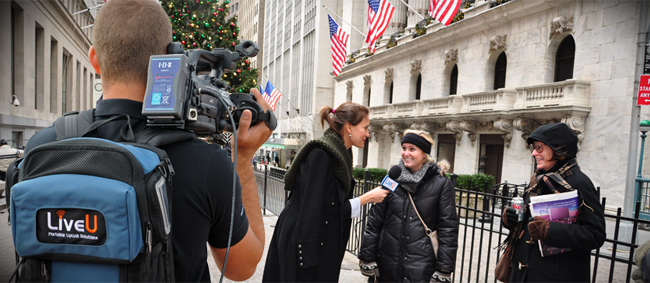Bonded cellular takes off in TV news despite limitations
For the past two years, the news departments at an increasing number of television stations have joined the ranks of bonded cellular users. The latest is Hearst Television, which this week announced a deal with vendor TVU Networks across 29 TV stations in 22 states.
Bonded cellular, offered by a growing list of companies that include Dejero, Integrated Microwave Technologies (Nucomm),TVU Networks, LiveU, Streambox, Teradek, DSI RF Systems and Vislink, has taken the news business literally by storm. It was, in fact, a storm that put the technology on the map in the first place.
WCBS in New York City was using bonded cellular from LiveU and TVU when a massive nor’easter and blizzard hit the day after Christmas in 2010. The massive storm dumped 32in of snow on the New York City area. It also changed the way WCBS did television news, allowing reporters to get out of news vehicles and walk to locations for live remotes.
Since then, other stations throughout the nation — citing the extreme portability, quick-to-air capability and low cost — have signed on with bonded cellular providers. Now, the trend is fundamentally changing TV news, both speeding up the exchange of information and slowing the deployment of older style and far more expensive microwave trucks and other remote equipment.

Hearst, with stations that reach 18 percent of U.S. households, evaluated several bonded cellular vendors. The group selected TVUPack, citing its high image quality and ease of use. In the coming months, Hearst plans to deploy the complete suite of TVUPack solutions across its network of affiliates to dramatically expand the group’s ENG capabilities and deliver live video from more locations.
TVU Networks, which features a one-button backpack in its TVUPack line, has been used to deliver live HD footage of a number of important events around the world, including the World Cup, the London Olympics, U.S. presidential elections, Hurricane Sandy and the 2013 papal conclave.
Bonded cellular is also affecting equipment purchasing at stations. The Raycom Media group recently purchased more than 130 JVC GY-HM650 ProHD mobile news cameras, which now features live streaming capability via cellular.
Raycom owns or provides services for 52 stations in 36 markets in 18 states, reaching more than 12 percent of U.S. TV households. Of those, 31 stations produce local news.
The bonded cellular feature was the impetus for Raycom’s decision to standardize on the JVC cameras, said Dave Folsom, vice president and chief technical officer for Raycom Media. He sees it as an additional ENG asset rather than a replacement for microwave-based news vehicles.
“We see both this exciting new camera technology as well as the use of cellular-enabled backpacks—we are also investing in these as well — as a supplement and not a replacement to traditional remote microwave capability,” he said. “In short, as we expand our news presence throughout the day and feed more screens — mobile and Internet — we need more compelling and fresh content. We see thee enabling technologies as a means to further that goal.”
JVC, which introduced the GY-HM650 at last year’s NAB Show, recently upgraded it with the ability to stream live video in the background while simultaneously recording video to multiple file formats. The camera uses a USB-docked Verizon 4G LTE modem.
Raycom started taking delivery of the updated GY-HM650s this month. JVC said 100 of its cameras will be used to replace aged-out ENG models, while another 30 will be used for expanding news operations.
Bonded cellular, which has been criticized for a lack of reliability — especially when many reporters are vying for the same limited bandwidth — has thrived nonetheless over two years of solid growth. Broadcasters have tried to negotiate priority bandwidth from carriers, but still must compete with all mobile users for bandwidth. However, new products to be shown at the NAB show will highlight significant improvements in signal transmission reliability.
For this reason, microwave trucks have remained dependable, bread and butter news tools for absolute reliable operations. But their high cost has opened the door to bonded cellular, which may be less reliable, but seems to be reliable enough in the new era of lower cost news coverage.
Get the TV Tech Newsletter
The professional video industry's #1 source for news, trends and product and tech information. Sign up below.
